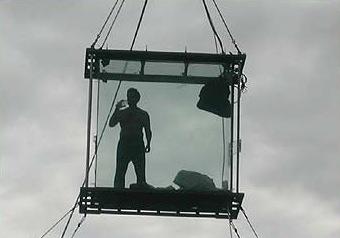Hyperoxic architecture
In this week's New Yorker there is a short blurb about "Richard Wiese, the president of the Explorers Club," who is getting ready "to climb a pair of volcanoes in Mexico."
The real challenge, it seems, will be in preparing his body for substantial changes in altitude – and so Wiese has installed an altitude chamber back home, in the center of his office.
An altitude chamber? "The air inside simulates that which you would breathe high in the mountains: it contains less oxygen" – which prepares your body for the trip ahead. (There are, in fact, whole university training courses in this).
The chamber, in other words, is hypoxic.

[Image: David Blaine, in a transparent box over the Thames – totally irrelevant to this post, but it looks hypoxic, so...]
What's fascinating here, aside from the levels of metaphor at work – the president of a prestigious Club in New York City, whose office is "on the third floor of a Tudor-style mansion on the Upper East Side," steps into his own private atmosphere everyday, a rarefied chamber of unearthly reserve, at one remove from the polluted ruins of Manhattan outside, a man of Olympus, breathing only the best oxygen his money could buy, etc. – but the terrestrial implications.
The geographic implications of an altitude chamber.
Much has been made of the so-called "horizontal" networks in which we now supposedly exist – I can phone someone in Adelaide, for instance, or order machine parts to be fabricated in Guangdong; it's all part of advanced globalization.
But an altitude chamber raises the intellectual stakes: this is the vertical linking of different, unconnected levels of the earth's atmosphere. The altitude chamber, as The New Yorker says, "simulates" other vertical levels of the planet. Sitting inside of one, you could talk down to what the article calls "a sea-level visitor" even while resting high and mighty – at the exact same level of altitude.
One could, in fact, very easily imagine the next trend in restaurant design: rather than decorate with a Thai theme, or Japanese decor, a Roman ambience, you'd have a 15,000-foot foyer, or an exclusive, 22,500-foot back room. It would be the literal depressurization of the social environment.
Who cares if you can eat in a restaurant that feels like Paris? When you could eat at a restaurant that feels like it's at 65,000 feet?
But I think I would prefer a hyperoxic chamber, in fact, because the more oxygen the better. Unless I burst into flame. But I could sit there, behind glass walls, like Lance Armstrong or the Oracle at Delphi, making elliptical pronouncements on a steady flow of pure oxygen about the virtuality of altitude, the simulational abilities of air itself – and I could impart upon legions of sealevel dwellers this vision of a new city, circular, utopian, made entirely of hyperoxic architecture, Euclidian, cubic, cylindrical, gleaming glass like crystal in every wall, people breathing, breathing, a city of nothing but ageless people breathing.
And the sun would set over a world of pressurized geometry.

[Image: Human-Rated Altitude Chambers.]
The real challenge, it seems, will be in preparing his body for substantial changes in altitude – and so Wiese has installed an altitude chamber back home, in the center of his office.
An altitude chamber? "The air inside simulates that which you would breathe high in the mountains: it contains less oxygen" – which prepares your body for the trip ahead. (There are, in fact, whole university training courses in this).
The chamber, in other words, is hypoxic.

[Image: David Blaine, in a transparent box over the Thames – totally irrelevant to this post, but it looks hypoxic, so...]
What's fascinating here, aside from the levels of metaphor at work – the president of a prestigious Club in New York City, whose office is "on the third floor of a Tudor-style mansion on the Upper East Side," steps into his own private atmosphere everyday, a rarefied chamber of unearthly reserve, at one remove from the polluted ruins of Manhattan outside, a man of Olympus, breathing only the best oxygen his money could buy, etc. – but the terrestrial implications.
The geographic implications of an altitude chamber.
Much has been made of the so-called "horizontal" networks in which we now supposedly exist – I can phone someone in Adelaide, for instance, or order machine parts to be fabricated in Guangdong; it's all part of advanced globalization.
But an altitude chamber raises the intellectual stakes: this is the vertical linking of different, unconnected levels of the earth's atmosphere. The altitude chamber, as The New Yorker says, "simulates" other vertical levels of the planet. Sitting inside of one, you could talk down to what the article calls "a sea-level visitor" even while resting high and mighty – at the exact same level of altitude.
One could, in fact, very easily imagine the next trend in restaurant design: rather than decorate with a Thai theme, or Japanese decor, a Roman ambience, you'd have a 15,000-foot foyer, or an exclusive, 22,500-foot back room. It would be the literal depressurization of the social environment.
Who cares if you can eat in a restaurant that feels like Paris? When you could eat at a restaurant that feels like it's at 65,000 feet?
But I think I would prefer a hyperoxic chamber, in fact, because the more oxygen the better. Unless I burst into flame. But I could sit there, behind glass walls, like Lance Armstrong or the Oracle at Delphi, making elliptical pronouncements on a steady flow of pure oxygen about the virtuality of altitude, the simulational abilities of air itself – and I could impart upon legions of sealevel dwellers this vision of a new city, circular, utopian, made entirely of hyperoxic architecture, Euclidian, cubic, cylindrical, gleaming glass like crystal in every wall, people breathing, breathing, a city of nothing but ageless people breathing.
And the sun would set over a world of pressurized geometry.

[Image: Human-Rated Altitude Chambers.]





Comments are moderated.
If it's not spam, it will appear here shortly!
I'm left wondering if you could grow – or, because of course you could – but what would happen, structurally, formally, botanically, if you grew hyperoxic gardens? Could you more or less sculpt a plant from seed to final form by toggling its oxygen? And what do flowers look like that have bloomed in conditions of altered oxygen? Do they bloom at all? Hypoxic gardening.
Or flowers that have bloomed in zero-gravity, for instance?
Or: introducing BLDGBLOG's Altitude Gardens®, a project for alto-terrestrial experimentation, flowers at different heights, seeds on space shuttles, gardens in the air...
Was he huffing out of a secret tank...? Giddy as can be.
you might dig this book
http://www.motherjones.com/arts/books/2005/11/thin_ice.html
Thin Ice: Unlocking the Secrets of Climate in the World’s Highest Mountains
Thin Ice focuses on the exploits of Lonnie Thompson, the relentless visionary behind the high-altitude climatology movement, one of the most promising areas of global warming research. For 30 years, he’s led expeditions to “every blank on the map he could find,” from the Andes to Kilimanjaro, to drill for ice cores, frozen time capsules that lock in air, dust, and pollution of climates past, and offer solid (literally) evidence of human impacts on the environment. Thompson has now spent more time in the “death zone” above 20,000 feet than almost anyone alive. Even his chief rival admits that Thompson’s insistence that the real climatological action is atop glaciers, not at the poles, has earned him a place “in the ranks of our great explorers.”
Hyperoxic rocker parties.
'World's highest gig' at Everest
http://news.bbc.co.uk/2/hi/entertainment/4403760.stm
Geoff- in response to your comment regarding hypoxic gardens- (maybe its far too late for you to get this?)
Oxygen is not the limiting factor for plant development- photosynthesizing organisms breath in CO2 and breath out O2. So a hypoxic environment could actually be beneficial, if the difference was made up with CO2.
Implications:
Inconvenient Truth is working at cross-purposes to the photosynthesizing community...plants want ever more CO2 in the atmosphere, the better to grow big and strong!
Also, other gasses have implications on plant development...have you heard of the hermetically sealed storehouses where green bananas, harvested early in El Salvador, are flooded with ethylene gas to artificially ripen them before sale? Hypoxic enviroments harnessed for the international fruit trade.
Hey Nathan - Got the comment. All new comments are emailed to me, actually, so even the old stuff is never too old to be new, so to speak...
In any case, your line about "hypoxic enviroments harnessed for the international fruit trade" is awesome! Worth exploring more, actually. The architectural construction of novel atmospheres, and the industries that support this. Could be a cool article there... Thanks!
Ever since I learned about the "ethylene rooms" used to ripen fruit, I've been marginally obsessed with the idea- supertankers modified to carry racks of giant banana bunches on steel hooks, tanks of liquid ethylene poised to flood open as soon as the ship nears a port- san francisco perhaps. Once the ethylene has been released belowdecks and the fruits (why limit yourself to bananas? strawberries, starfruit, breadfruit, asian pears...) are happily ripening, signage is posted "KEEP OUT: Ripening environment is toxic to humans! PELIGRO!" Unfortunately, sometimes stowaways make their way onto the ship, their well-ripened corpses found only when the belowdecks are unloaded at port...
Indeed. Perhaps the plot of some future zombie horror film is becoming clear...
The Ripe and the Dead.
Deadfruit: The Beginning.
"A new era in hypoxic horror..."
Now you've done it...
I've been reading this long enough that every post of yours spins off another two in my head...i'm starting my own blog at http://reclaimant.blogspot.com/
And it's all your fault.
Post a Comment